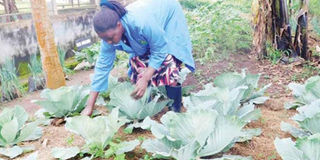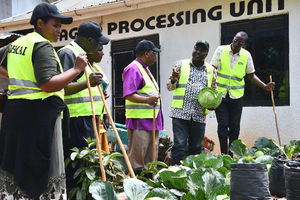
Constance Ithungu an instructor at Kamenyamiggo Agriculture Institute says vegetables can be commercially grown on a small piece of land. PHOTO/MICHAEL J SSALI
Food scarcity in towns is linked to poverty, malnutrition, and crime, among other social ills. However with innovation and hard work food scarcity stimulates employment opportunities when people commit themselves to food generation, value addition and distribution.
It is often referred to as urban and peri-urban farming (UPF) and it is practiced in towns and near or around large urban centres in places where low income earners mostly live.
Growing crops, processing or value addition, keeping livestock and food distribution in urban areas can be quite paying occupations.
How it is done
However poor people can be assisted to produce some of their food by teaching them how to grow it in small spaces. It is possible to grow vegetables on sacks of soil placed on verandahs and compounds. Vegetables may be grown in soil contained in plastic containers such as basins and drums.
They can tether small ruminants such as goats and sheep or even keep rabbits in cages. Those living near swamps can make ponds and do fish farming. Some urban farmers may also practice horticulture seedlings preparation for sale to the affluent members in cities to beautify their compounds.
Some people may get into enterprises such as livestock keeping and sell products such as eggs, milk, and honey to fellow residents at fairly low prices.
When an item like milk is produced in the same area where the consumers live the individual selling it should not incur big transport costs because he does not have similar transport difficulties as the cattle keeper of Lyantonde District who must take his milk to Kampala to sell it.
Urban milk
The urban milk producer is more likely to charge less because many of the consumers will even be ready to walk to the farmer’s homestead to pick the milk.
Zero-grazing of animals like pigs, cows, or keeping poultry are some of the enterprises that an innovative farmer can consider taking up. Some people can practice greenhouse farming to produce valuable amounts of vegetables in towns.
Two teachers, Ritah Nakitto and her husband Benjamin Ssentongo Banadda, took a decision to quit teaching about 12 years ago and to set up Banadda Smart Farm at Gangu on Busaabala Road in Kampala.
Their farm, measuring 156 feet by 89 feet, today easily passes as one of the most successful stories of urban farming in the country. She used to teach History and CRE in one of the St Lawrence Secondary Schools (Creamland) and he used to teach History and Luganda at Wanyange Girls School.
“We both had a strong passion for farming, and that is why we have always been keen readers of Seeds of Gold and other farming publications,” Benjamin says.
They prepare and sell vegetable seedlings, they grow and sell vegetables and they also grow enough bananas and potatoes for the family to feed on.
Advice
In her speech recently at the Lyantonde Agricultural Show, where she was guest of honour, Robinah Nabbanja, prime minister of Uganda emphasised the importance of choosing agricultural enterprises that small scale farmers can carry out successfully.
“If you have a small piece of land, don’t go into enterprises like maize production because you need a big area to produce a large amount of it to make good profit,” she cautioned.
UPF is more determinable because it does not so much rely on natural conditions to carry out. It relies more on irrigation than on rainfall because town councils have piped water. This applies to keeping livestock such as pigs, sheep, poultry, sheep and cattle. The water is usually readily available for the animals and birds to drink.
Fodder is in the form of tree branches like mango and mutuba trees and grass cut from the road sides or from the wild bush wherever it can be found. Fodder grass may be grown around the homestead or along the trenches in the garden.
Many urban farmers collect left-over food from restaurants, banana and sweet potato peelings and some unsold green vegetables judged unfit for human consumption.
An urban farmer puts a lot of attention and care on his crops and animals because they live close to him all the time and the yields are usually high. He has minimal transport costs since he also lives near his customers.
UPF is a form of low cost employment and it reduces the burden of waste disposal since some of the garbage is used to feed livestock by the farmers. Some of the waste is used as organic manure to fertilise the farmers’ gardens. It is a way of waste recycling.
It is a good form of agribusiness enterprise for people who engage in buying and vending as well as value addition.
Without urban farming hunger and malnutrition would be much worse among the urban poor.
Robert Munyoloaganze, a resident of Manywa Village, Kyannamukaaka Sub-county, Masaka District is a successful smallholder farmer who is also keen on sharing his farming skills with other people particularly the youth that are interested in farming but have small plots of land.
Disadvantages
UPF has its disadvantages however. Usually animals like pigs and cattle are kept rather near the houses where the farmers live and the proximity is a health risk. Livestock droppings attract flies and germs. When it rains the runoff water spreads animal droppings and germs to neighbouring compounds where people might be inconvenienced by the stench.




